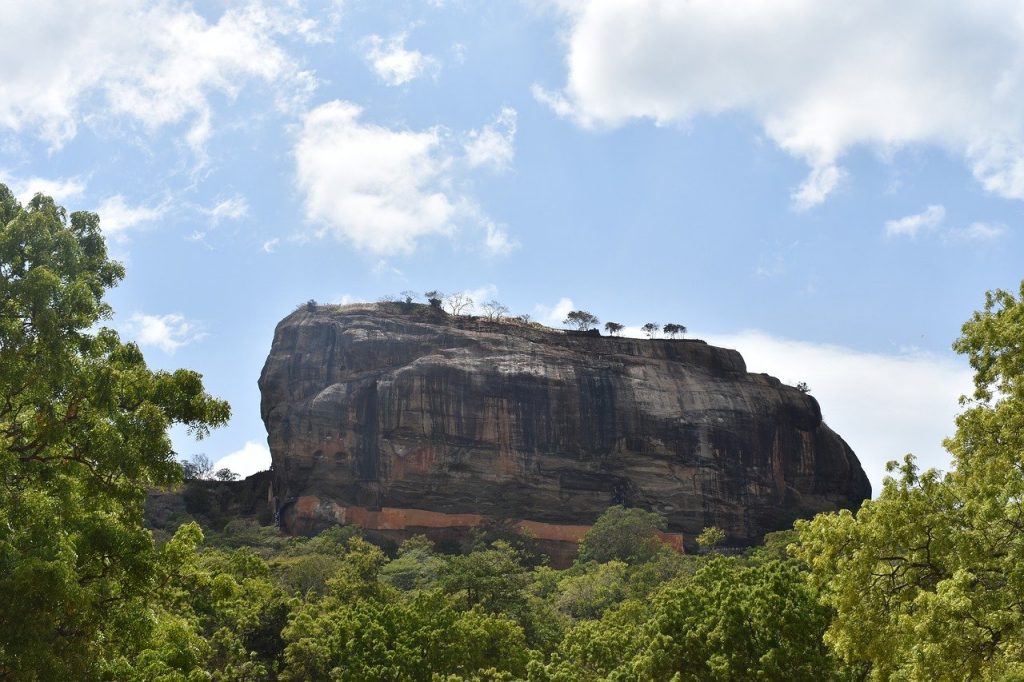Sigiriya is one of the most valuable historical monuments of Sri Lanka. Referred by visitors as the Greatest Wonder of the World this ancient palace and fortress complex has significant archaeological importance and attracts millions of tourists every year.
It is probably the most visited tourist destination of Sri Lanka.

The palace is located in the heart of the island between the towns of Dambulla and Habarane on a massive rocky plateau 370 meters above the sea level.
Sigiriya rock plateau, formed from magma of an extinct volcano, is 200 meters higher than the surrounding jungles. Its view astonishes the visitors with the unique harmony between the nature and human imagination.
The fortress complex includes remnants of a ruined palace, surrounded by an extensive network of fortifications, vast gardens, ponds, canals, alleys and fountains. The surrounding territories of Sigiriya were inhibited for several thousand years.
Since 3rd century BC the rocky plateau of Sigiriya served as a monastery. In the second half of the 5th century king Kasyapa decided to construct a royal residence here.
After his death Sigiriya again became a Buddhist monastery until the 14th century, when it was abandoned.

The main entrance is located in the northern side of the rock. It was designed in the form of a huge stone lion, whose feet have survived up to today but the upper parts of the body were destroyed.
Thanks to this lion the palace was named Sigiriya. The term Sigiriya originates from the word Sihagri (Lion Rock).
The western wall of Sigiriya was almost entirely covered by frescoes, created during the reign of Kasyapa. Eighteen frescoes have survived to this day.

The frescoes are depicting nude females and are considered to be either the portraits of Kasyapa’s wives and concubines or priestess performing religious rituals. Despite the unknown identity of the females depicted in the frescoes, these unique ancient paintings are celebrating female beauty and have incredible historical significance.

Access
Sigiriya is located 175 km north-east of Colombo and 10 km from the highway Ambepussa-Kurunegala-Trincomale, located between the towns of Dambulla and Habarane.
To get there by car take the track A1 or A6. The best way to get there by public transportation is to take a bus from Dambulla.
There is a bus every 30 minutes starting from 7AM. The trip will take approximately 40 minutes.
A staircase of 1250 steps is leading to the highest point of Sigiriya. The way from the bottom to the top lasts approximately 2 hours. Because of the high temperatures during the day, it is better to visit the place in the morning. Wear comfortable clothing, take water with you and don’t forget to bring a hat and sunscreen.
The ancient site is open every day from 7:00AM to 5:30PM (last entrance at 5:00PM).
History
Archaeological excavations have proven that Sigiriya and its surrounding territories were inhabited for more than 4000 years.
Since the 3th century BC Sigiriya was used as a monastery and after eight centuries it was turned into a royal palace.
The construction and early history of the palace and fortress of Sigiriya is connected with several tragic events in the relationship of two royal brothers – Kasyapa and Moggallana. King Kasyapa (477-495 AD) illegally took the throne.
The legal heir of the throne Moggallana was forced to escape to India. Fearing an attack by his brother Kasyapa decided to move the capital from Anuradhapura to the central parts of Sri Lanka. He constructed a royal palace on a high rock to make sure it will not be invaded by the right heir of the throne Moggallana.
The palace – Sigiriya was constructed using the most advanced technologies of the time and was richly decorated with colourful frescos. After Kasyapa was killed in the battle with his brother’s army, the capital was moved back to Anuradhapura.
Moggallana destroyed the palace of his brother and Sigiriya became a Buddhist monastery again. Approximately a thousand years later – in the 14th century it was abandoned also by monks.
In 1831, Jonathan Forbes, a major of the British army accidentally discovered Sigiriya on his way from Polonnaruwa.
The site immediately attracted the attention of historians and archaeologists, but only in the 1980s major excavations took place here.
Archaeologists discovered the 5th century citadel, royal palace, gardens, parks and 1500 years old frescoes on the western wall of the complex, some parts of which remained amazingly unaltered.
Reference: Sigiriya Tourism

